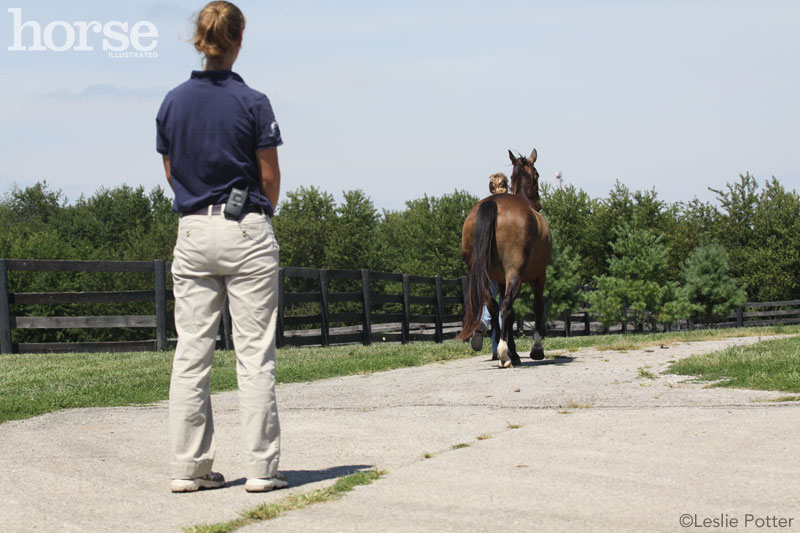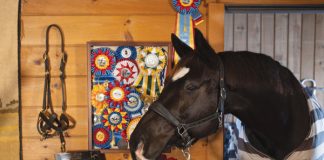I was steadily working my way through the day’s calls. It was very busy, and as I marched down the barn aisle to see an old pony named Snort who was having some vision problems, I was stopped by a boarder.
“How long has she been like that?” I asked
The woman couldn’t really say. Apparently M’lady, a stout Quarter Horse, was having some nonspecific pain and performance issues. She was 14, had never had any problems in the past, and the owner was worried. I didn’t know how I was going to get through my already packed schedule, but I agreed to see the mare after I’d checked on Snort.

Looking for Lameness
We brought M’lady into the arena and I watched her carefully as the owner longed her at the walk, trot and canter. She circled M’lady in both directions, then got on her and repeated the gaits. The mare moved beautifully. I was puzzled, and moved them outside to a harder footing and watched for almost 20 minutes. M’lady wasn’t lame, she wasn’t in pain and there were no performance issues.
Puffing, the owner finally pulled up next to me. “Did you see it? Did you notice how she hesitated slightly when moving out of the canter and how her tail occasionally pulls off to one side? And every now and then she works her jaw really hard? I know she’s in pain!”
I opened my mouth, and then closed it again.
The owner continued. “And when I tacked her up just now, she closed her eyes halfway, and then took a step backward. Dr. Diehl, I have a lot of confidence in you. I know you can help my poor, sweet angel!”
In the Eye of the Beholder
Nonplussed, I scrambled for something logical to say or do, as I just wasn’t seeing any problems with the mare. Then I had it: I’d do some flexion tests, and maybe I’d see what the woman was talking about.
I lifted each limb in turn, holding the joints in a flexed position to look for hidden sources of pain and watched carefully as the owner jogged her off. Nothing. I palpated her jaw, her neck, withers, lower back and pelvis. Nothing. Her hooves were shod to perfection and there was no response to hoof testers. Her ribs were fine. Her muscles palpated normally. I even opened her mouth and admired the long rows of immaculately floated teeth. Her tack was pristine and her saddle was custom made to fit her back properly.
The owner looked at me expectantly but her smile dimmed when I admitted that I couldn’t find anything wrong with the mare.
“My trainer thinks it’s her feet and wants me to use her farrier. She’s sure it will fix the problem.”
“I’m afraid I don’t see the problem with the feet. They look perfect, and more importantly, she moves beautifully,” I said.
The woman’s face was serious and she pointed to the hooves again. “My trainer wants her in Magic Symmetry shoes. Her farrier is a certified Magic Symmetry lameness specialist and consultant. I was very lucky to get him to watch M’lady last week and he explained to me how uncomfortable she is and how she can’t move properly with these shoes she’s wearing. I must say, I’m surprised that you can’t see it!”
I politely explained that the mare was showing no signs of pain or performance issues, and that her existing farrier was perfectly adequate. I asked the owner to call me if anything changed, and noting her dissatisfaction, I packed up my stuff and left. On the drive home, I questioned myself, even though I knew better. Had I missed something? Was there really a performance issue that I wasn’t seeing?
I thought I wouldn’t hear from the owner again, but she called the next week to report more problems, mostly noticed by the trainer, and I dutifully went back out, repeated the whole exam, and again, found nothing. I could see that the woman wasn’t happy with me, but what could I do?
A Turn for the Worse
I put the strange incident out of my mind, and several weeks had passed before I saw M’lady in the arena one day, the trainer on her back. The mare labored miserably through an awkward canter, her head bobbing furiously, then broke to a choppy trot and staggered to a halt, sides heaving. There seemed to be a group of women watching her.
I couldn’t get to M’lady fast enough. Here was the problem the owner had been describing! Perhaps I could finally get a diagnosis and redeem myself.
“Wow, I can really see the lameness now!” I called loudly to the trainer. “I’m here at the barn for a few hours if you need me to look at her again.”
A few women looked over at me wide-eyed, and the trainer glared but didn’t reply.
“Is the owner here? This would be great for her to see!” I boomed enthusiastically. “Look at how sore M’lady is. It’s really obvious today!”
The watching women were now open mouthed, and I stopped in confusion, certain that I had recognized M’lady’s owner among them. The trainer got off M’lady and stalked away furiously, yanking the mare along behind her. I noticed a short skinny man wearing a shoeing apron among the crowd of women and he scowled deeply as he elbowed through the small group and marched past me. A Magic Symmetry pamphlet fluttered to the ground in his wake.
A woman rushed up to me frantically.
“Dr. Diehl, you’ve interrupted a very important event. They were just giving a demo to the barn on how Magic Symmetry shoes have really enhanced and improved M’lady’s performance since she was shod in them last week!”
Liked this article? Read past Vet Adventures columns:
Foal Wrangling
It’s Called a Pre-Purchase Exam for a Reason
The Colic Call
COURTNEY S. DIEHL, DVM, has been an equine veterinarian since 2000. She resides in Steamboat Springs, Colo., where she is in private practice. Her first book, Horse Vet, Chronicles of a Mobile Veterinarian, was published in 2014, and she is currently at work on her second book.
This article originally appeared in the December 2015 issue of Horse Illustrated magazine. Click here to subscribe!





